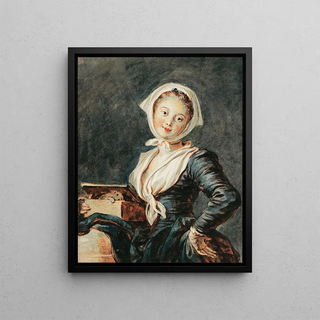Art print | The Girl with the Marmot - Jean-Honoré Fragonard


View from behind

Frame (optional)
In the vibrant universe of 18th-century art, one work stands out for its lightness and charm: "La Fille à la marmotte" by Jean-Honoré Fragonard. This painting, emblematic of rococo, invites viewers to immerse themselves in a world where frivolity and sensuality intertwine. Fragonard, an undisputed master of color and light, manages to capture a moment of life filled with sweetness and carefree joy. The depicted scene, where a young girl delicately holds a marmot, evokes an atmosphere of playfulness and tenderness, while revealing the subtleties of lush nature. This artwork, through its composition and subject, offers an invitation to contemplation and daydreaming.
Style and uniqueness of the work
"La Fille à la marmotte" is characterized by its typical rococo style, where exuberance blends with a certain lightness. Fragonard uses a palette of soft colors, from delicate pinks to soothing greens, creating a visual harmony that captivates the eye. The young girl, dressed in a light dress, seems to flourish in a natural environment that enhances her beauty. The treatment of textures, whether in her dress fabric or in the marmot's fur, demonstrates the artist's technical mastery. The composition, meanwhile, is skillfully orchestrated, with curved lines guiding the eye and reinforcing the scene's dynamics. Fragonard thus manages to infuse a palpable life into his characters, making them almost tangible. This artwork is more than a simple representation; it is a celebration of beauty and ephemerality, a frozen moment in time.
The artist and his influence
Jean-Honoré Fragonard, born in Grasse in 1732, is one of the most emblematic painters of the rococo movement. A student of François Boucher, he quickly developed a style unique to him, combining sensuality and lightness. His work is distinguished by an innovative approach to color and light, as well as a capacity to capture the essence of everyday life.

Matte finish

View from behind

Frame (optional)
In the vibrant universe of 18th-century art, one work stands out for its lightness and charm: "La Fille à la marmotte" by Jean-Honoré Fragonard. This painting, emblematic of rococo, invites viewers to immerse themselves in a world where frivolity and sensuality intertwine. Fragonard, an undisputed master of color and light, manages to capture a moment of life filled with sweetness and carefree joy. The depicted scene, where a young girl delicately holds a marmot, evokes an atmosphere of playfulness and tenderness, while revealing the subtleties of lush nature. This artwork, through its composition and subject, offers an invitation to contemplation and daydreaming.
Style and uniqueness of the work
"La Fille à la marmotte" is characterized by its typical rococo style, where exuberance blends with a certain lightness. Fragonard uses a palette of soft colors, from delicate pinks to soothing greens, creating a visual harmony that captivates the eye. The young girl, dressed in a light dress, seems to flourish in a natural environment that enhances her beauty. The treatment of textures, whether in her dress fabric or in the marmot's fur, demonstrates the artist's technical mastery. The composition, meanwhile, is skillfully orchestrated, with curved lines guiding the eye and reinforcing the scene's dynamics. Fragonard thus manages to infuse a palpable life into his characters, making them almost tangible. This artwork is more than a simple representation; it is a celebration of beauty and ephemerality, a frozen moment in time.
The artist and his influence
Jean-Honoré Fragonard, born in Grasse in 1732, is one of the most emblematic painters of the rococo movement. A student of François Boucher, he quickly developed a style unique to him, combining sensuality and lightness. His work is distinguished by an innovative approach to color and light, as well as a capacity to capture the essence of everyday life.






